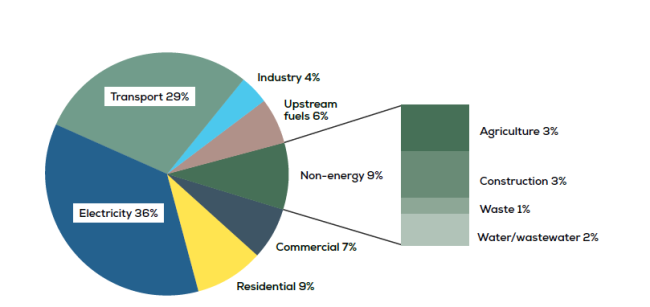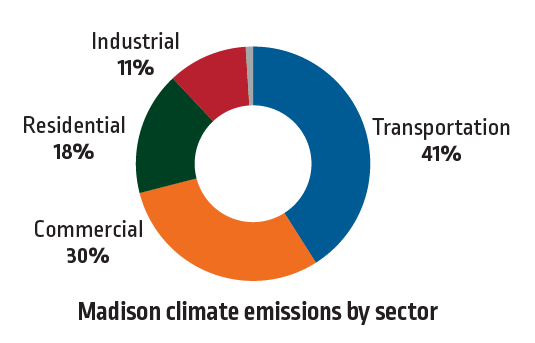Sharon Lezberg, Community Development Educator
Drive, bike, or bus- decisions, decisions! Like most American adults, I can easily jump in my car to travel from place to place. I may be concerned about the price of gas, or gridlock on the road, but how often do I think about the tailpipe emissions that I’m generating? How often am I tabulating my contribution to the ever increasing store of greenhouse gases in the atmosphere? Honestly, I worry a lot about emissions, but justify driving due to limited alternatives. Bus routes are infrequent and inconvenient, and biking doesn’t fit my schedule with multiple meetings. I’ve made countless excuses for my car addiction, realizing that change is more challenging than excuses! What will it take for me – and others – to reduce vehicle miles traveled?
The Dane County Climate Action Plan provides an analysis of greenhouse gas emissions (GHG) and their sources. According to the models, 29% of GHGs in the County stem from the transportation sector. To reduce emissions from transportation, the plan emphasizes transitioning to electric vehicles, using renewable natural gas for heavy vehicles, and, most importantly, reducing vehicle miles traveled (VMT). Simply put, drivers must choose alternatives like buses, bikes, or walking whenever possible. While the plan aims for a 15% VMT reduction, Kathy Kuntz from the Dane County Office of Energy and Climate Change emphasizes the need to go even further due to anticipated growth in our region.

The City of Madison attributes 41% of local greenhouse gas emissions to the transportation sector (based on the 2015 Greenhouse Gas Inventory). The percent assigned to the transportation sector in the City of Madison is greater than that of the County for several reasons: Madison is an urban residential and employment hub, so many people are commuting both within the city and to/from the city from outlying areas; sectors such as agriculture aren’t as much in play in an urban environment; and there are some differences in how emissions were counted.

Madison’s updated climate action plan – Climate Forward Madison – touts several low-carbon strategies to reduce the outsized contribution of the transportation sector to the GHG inventory: initiation of the bus rapid transit system with electric buses; expansion of public transportation service; transit oriented housing development; expansion of bicycle infrastructure; and pedestrian safe street crossings.
Strategies to reduce VMT
The Capital Area Regional Planning Council’s (CARPC) Regional Development Framework identifies three goals for the region:
1) reduce greenhouse gas emissions and foster community resilience to climate change;
2) increase access to jobs, housing and services for all people;
3) conserve farmland, water resources, natural areas, and fiscal resources.
Each of these three goals can be met through the objective “increase percent of development that is compact, mixed, walkable, and where feasible, transit supportive.” CARPC aligns the regional development framework with the Greater Madison Metropolitan Planning Organization’s (MPO) Regional Transportation Plan, which identifies priorities for transportation investment to assure equity and fiscal considerations as the region grows.
If we get housing and development wrong – for instance, if there are no limits put on sprawl, which eats up prime agricultural land and natural areas – then transportation planning goes bust. For example, multifamily housing developed along transportation corridors assures transport ridership. In contrast, single family, large lot housing development in areas where there is no transportation infrastructure (such as in rural communities) leaves workers with no choice but to drive (and to drive up VMT). Conversely, rural farmland and woodland are important carbon sinks (absorbing carbon dioxide from the atmosphere); when rural natural areas are plowed up for residential development, carbon dioxide is released and the future potential of the carbon sink is lost.
In order to reduce vehicle miles traveled, our communities will need to develop reliable, rapid, and widespread public transportation systems. This will take incremental steps to achieve. The first of these steps is to couple land use and development planning with transportation planning. ‘Transit oriented development’ does just that, by focusing population (housing) growth in urban centers and along major transportation corridors, and by prioritizing growth in dense population centers that are well served (or could be well served) by transportation options.
Hopping on the Bike; Getting on the Bus
Transit oriented development, expansion of public transit options, and expanded infrastructure for safe walking and biking are essential for reducing vehicle miles traveled. But are we – the drivers – ready for the transition?
Reducing vehicle miles traveled is a joint venture – Municipalities must invest in adequate infrastructure development, and individuals must be willing to transition to multimodal transportation options. This doesn’t mean ditching our cars entirely; it means making choices that take into consideration the impact getting into the vehicle has on the planet. If jumping on the bus or bike would lead to fewer tailpipe emissions, less gridlock, and fewer accidents, wouldn’t it be worth it?
Doubtless, most of us would benefit from fewer trips in cars. Using pedestrian and bike transportation, where possible, is enjoyable, a source of exercise, and saves on costs of fuel, parking, and maintenance. With these benefits, why is it so difficult to make the transition? I’d tally it up to the personal freedom afforded by the automobile; the opportunity to go where you want, when you want. And what about if we can’t walk or ride? For many, health or time limitations can make biking or walking a non-starter. For most individuals, robust, accessible, and consistent public transportation is the key to reducing VMT.
For me, having a mindset of ‘stop, pause, consider’ is going to drive my own behavior change. Instead of leaning on excuses, I’ve set a goal to reduce my own personal vehicle miles traveled. Just having this goal serves as a reminder to me to consider options for any trip I’m about to take. We’ll see how it goes; I welcome you to join me in this challenge!
Resources on Reducing Vehicle Miles Traveled
Performance Indicator Spotlight – Vehicle Miles Traveled (CARPC)
CARPC Regional Development Framework
CARPC blog: Sun Prairie Takes an Integrated Approach to VMT Reduction
Connect Greater Madison 2050 Regional Transportation Plan
Vehicle Miles Traveled – Streetsmart
Onestl.org (Saint Louis region) toolkit
EPA Transportation Control Measures
Sources
Dane County Climate Action Plan
City of Madison Sustainability & Resilience – Transportation webpage
Climate Forward Madison 2022
CARPC 2050 Regional Development Framework (info sheet). 2022
Greater Madison Metropolitan Planning Organization – Regional Transportation Plan




